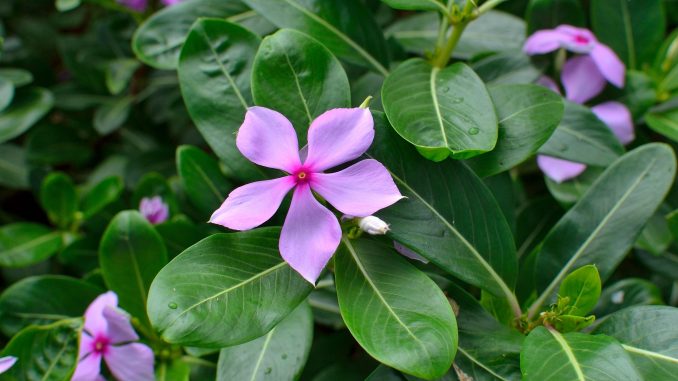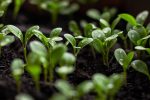
Catharanthus roseus (syn. Vinca rosea) extracts have revolutionised cancer therapy. The plant produces indole alkaloids which were first identified by pharmaceutical businesses in the 1950s searching for a cancer cure. These alkaloids reduce the number of white blood cells which led to interest in their medicinal properties. The alkaloids are extremely toxic when purified and quite different when compared to the whole plant extract.
The common name for the plant is Madagascan Periwinkle, rosy periwinkle and Cayenne jasmine.
Uses
The leaves are the main source of any drugs. It is an astringent herb that reduces blood sugar levels hence its interest in diabetes management. It also increases perspiration and stimulates the uterus. The isolated indole alkaloids treat leukaemia especially in children, Hodgkin’s disease and lymphoma, and other cancers with side effects such as nausea, alopecia and bone marrow depression.
The various uses in certain countries are the following:-
- diabetes (West Indies)
- diabetes, hypertension, chronic constipation, indigestion (Vietnam, Mauritius, Surinam).
- menstrual regulation (Africa, Philippines)
- asthma (Bahamas)
Cultivation
The plant is an ornamental and very tender. It enjoys living in moist, well-drained soil in sun. The temperature minimum is 18 °C for seedling to sprout reducing to 13°C. for plant growth. Propagate by seed sown in spring; buy cuttings of non-flowering shoots in spring. Cut back in spring to maintain a low compact shape. Low temperatures and excessive wet cause fungal rotting.
The leaves are collected before and during flowering. These are dried for infusion, liquid extracts and tinctures, and for the release of alkaloids.
Do not eat as it is highly toxic.
The Cell Culture Of Madagascan Periwinkle
This plant species is widely used in plant cell culture for the production of important secondary metabolites called indole alkaloids. Indole alkaloids are a diverse class of compounds known for their pharmacological activities, including anti-cancer, anti-microbial, and anti-hypertensive properties. Vinblastine and vincristine, two well-known anti-cancer drugs, are derived from C. roseus and have been instrumental in cancer treatment.
Plant cell culture techniques provide a controlled environment for the growth and propagation of plant cells in a laboratory setting. The plant cell culture of Catharanthus roseus and the subsequent production of indole alkaloids provides a classic example of the genre. The following is a summary of the general approach to C. roseus cultivation and comes from a number of reviews but especially Moreno et al., (1995).
- Callus Induction: The process starts with the establishment of callus cultures, which are undifferentiated masses of cells obtained by culturing plant explants (e.g., leaf, stem, or root fragments) on a nutrient medium supplemented with plant growth regulators like auxins and cytokinins. The callus serves as the starting material for subsequent steps.
- Cell Suspension Culture: Callus cultures can be subcultured into liquid media to establish cell suspension cultures. In this stage, the callus cells are dispersed in a liquid medium and agitated gently. The cell suspension culture allows for higher cell growth rates and facilitates the production of metabolites.
- Indole Alkaloid Biosynthesis: The cells in suspension culture are capable of producing indole alkaloids, including vinblastine and vincristine. The biosynthesis of these alkaloids is regulated by specific enzymes and biochemical pathways within the plant cells. Precursors such as tryptamine and secologanin are synthesized, and through a series of enzymatic reactions, they are converted into various indole alkaloids.
- Optimization and Enhancement: Various factors, including nutrient composition, hormone levels, pH, temperature, and light conditions, are optimized to enhance indole alkaloid production. This involves fine-tuning the culture conditions to stimulate the activity of key enzymes involved in alkaloid biosynthesis.
- Extraction and Purification: Once the desired alkaloids are produced, they are extracted from the culture medium or the plant cells. Techniques such as solvent extraction, solid-phase extraction, and chromatography are used to isolate and purify the alkaloids.
Plant cell culture of C. roseus offers several advantages for the production of indole alkaloids:
- It provides a controlled and reproducible system for the production of specific compounds.
- It offers a continuous and sustainable source of indole alkaloids, which may be challenging to obtain from the whole plant.
- The culture conditions can be optimized to maximize alkaloid production.
- The production process can be scaled up from small laboratory-scale cultures to large bioreactors, allowing for commercial production.
However, there are some challenges associated with plant cell culture of C. roseus, including the low yield of alkaloids in some cell lines, genetic instability, and the complexity of the biosynthetic pathways involved in alkaloid production.
Overall, plant cell culture techniques have played a significant role in the production of indole alkaloids from Catharanthus roseus, facilitating the development of valuable pharmaceuticals with therapeutic potential.
References
Moreno, P.R.H., van der Heijden, R. & Verpoorte, R. (1995) Cell and tissue cultures of Catharanthus roseus: A literature survey. Plant Cell Tiss. Organ Cult 42, pp. 1–25 (Article)

Leave a Reply